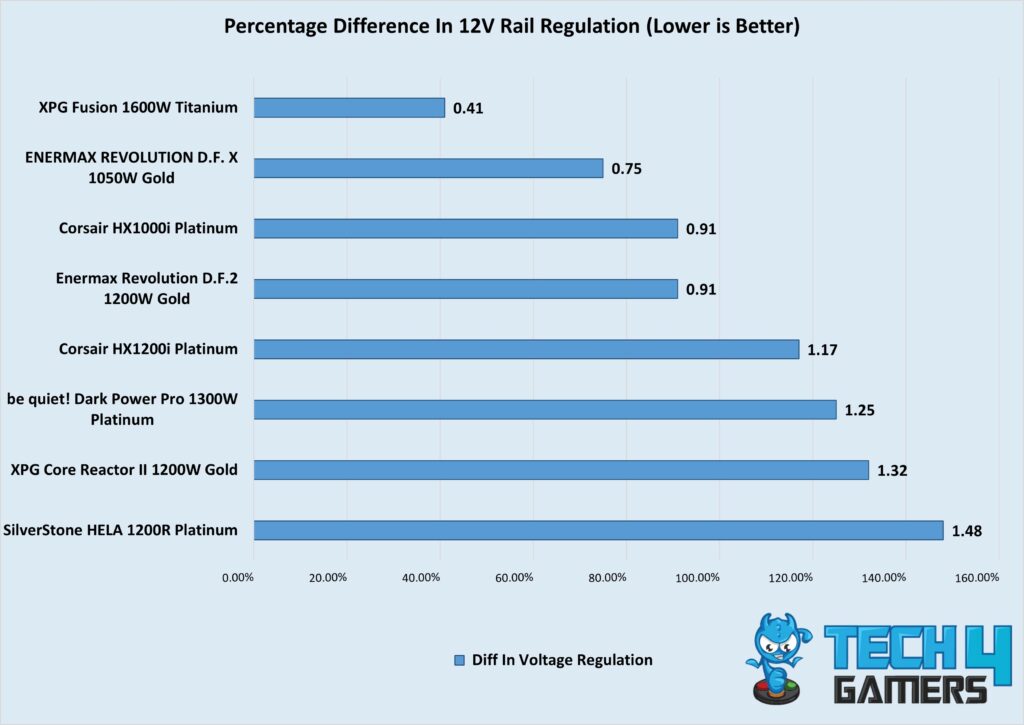Power is not the only thing that keeps things on. Maintaining stability and efficiency is also crucial. The secret lies in PSU voltage regulation, so let’s understand how to optimize the regulation in your power supply.
Key Takeaways
- Voltage regulation is the ability of a PSU to maintain a stable output voltage regardless of any spikes and dips in the AC voltage.
- Regulating voltage at a stable rate is essential for the PC build’s stability, performance, and longevity.
- A good PSU must keep the regulation under 3%, which means the actual voltage must fluctuate by no more than 3%.
What Is PSU Voltage Regulation?
PSU voltage regulation is the ability of the power supply to maintain a stable output voltage regardless of changes in load or input voltage.
Stable regulation is achieved through optimal circuitry inside the power supply, which monitors and adjusts the output voltage as needed.[1] This regulation is the PSU’s capacity to supply voltage within a tight range.
Why Does PSU Voltage Regulation Matter?
The importance of this regulation can’t be overstated. Some of the reasons why it matters are as follows:
- Stability: Poor voltage regulation leads to an unstable power supply, which can cause many issues, such as system crashes.[2] Maintaining a stable voltage saves crucial CPU, GPU, and memory components.
- Longevity: High voltage spikes and drops can cause undue stress on PC components, which can cause system failure. Proper voltage levels are unavoidable to prevent damage to the rig.
- Performance: Power-hungry components like the CPU and GPU require stable power to function fully. Voltage fluctuations can cause throttling, which lowers their efficiency and prevents the system from overheating.
The differences in 12V rail regulation of different PSUs that we tested are given below:

What Is Good PSU Voltage Regulation?
The ideal difference between the input AC power and the output DC power should be 0% to get the most efficient and good performance. However, in the real-world scenario, the 3% or less voltage regulation is good for high-quality power supplies even under heavy loads.[3] This voltage regulation means the fluctuations will be 3% or less from a typical voltage range.
So, buy a PSU with the lowest voltage regulation percentage for the best performance and to keep your PC from unwanted circumstances like short circuits or overheating.
Helpful Resources by Tech4Gamers:
References:
- GeeksforGeeks. (2024, January 24). Voltage Regulation. GeeksforGeeks. https://www.geeksforgeeks.org/voltage-regulation/
- Voltage regulation in the Douglas area using shunt capacitor banks and controllable shunt reactors. (2013, November 1). IEEE Conference Publication | IEEE Xplore. https://ieeexplore.ieee.org/document/6737888
- Introduction – 2.11 – ID:613768 | ATX12VO (12V Only) Desktop Power Supply. (n.d.). https://edc.intel.com/content/www/us/en/design/products-and-solutions/processors-and-chipsets/alder-lake-s/atx12vo-12v-only-desktop-power-supply-design-guide/2.11/
Frequently Asked Questions
A voltage regulator within a PSU is a circuit that maintains a stable output voltage regardless of input fluctuations or load changes.
The 3.3V rail is less common in modern systems and powers components like M.2 SSDs, some PCIe devices, and specific motherboard chips.
The ideal regulation is 0%, but try to get a PSU with the lowest voltage regulation percentage.
Thank you! Please share your positive feedback. 🔋
How could we improve this post? Please Help us. 😔
[Errors Troubleshooting Expert]
Arsalan Shakil (aka GuyThatDoesEverything on YouTube) is a PC Tech Enthusiast and Electronic Geek. With over 10+ years of experience in Electronics, he then decided to explore Software Engineering to design embedded products and automate existing hardware solutions.
When he started tearing down old cameras to understand how they worked, he was shocked (literally, when he got zapped by a flash discharge capacitor), giving him the power (debatable) to fall in love with videography/photography. He also started making some fun videos that later became YouTube tech reviews.
Skills:
- 10+ years of experience in Electronics design, embedded solutions, and prototyping
- Majored in Software Engineering
- Research paper publication in IEEE for Embedded Military Uniform & LoRa WAN wireless technology
- Specialized in IoT Solutions
- PC Enthusiast & PC Modder
In his local region, he’s known to expose cheap PSU brands, often claiming fake certification or false claims on the box. He’s a true nerd and needed some friends in his life. Then he met some guys who work at Tech4Gamers, and they also came out to be equal nerds who suggested he join Tech4Gamers as a Hardware Expert.


 Threads
Threads
![PSU Voltage Ripple [Explained] 12V Rail Transformer and MOSFETs Mounted on the Vertical Daughter Board (Image By Tech4Gamers)](https://tech4gamers.com/wp-content/uploads/2024/05/MSI-MPG-A850G-850W-12V-Rail-Transformer-and-MOSFETS-Mounted-on-the-Vertical-Daughter-Board-Image-By-Tech4Gamers-218x150.jpg)
![What Is Overclocking? [The Definitive Guide] What Is Overclocking](https://tech4gamers.com/wp-content/uploads/2023/02/What-Is-Overclocking-218x150.jpg)

![AMD EXPO [Features & How You Can Enable It]](https://tech4gamers.com/wp-content/uploads/2024/08/CORSAIR-VENGEANCE-RGB-DDR5-RAM-32GB-2x16GB-6000MHz-CL30-AMD-EXPO-RGB-Lighting-3-218x150.jpg)